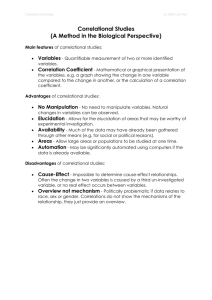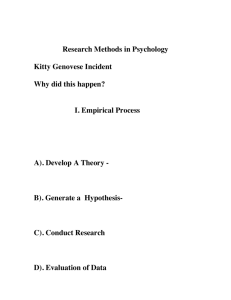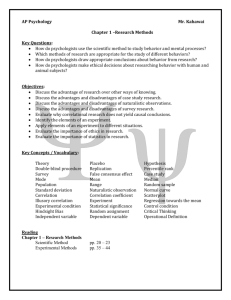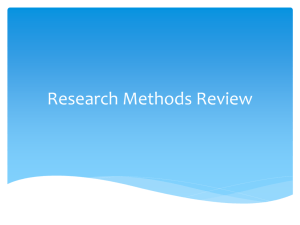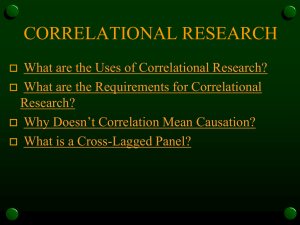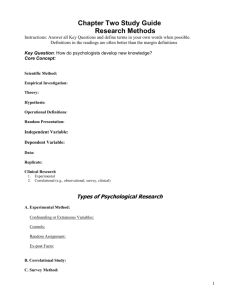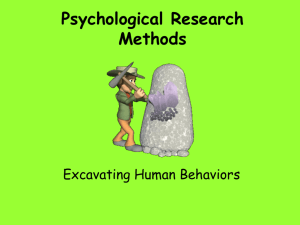Chapter 2
advertisement
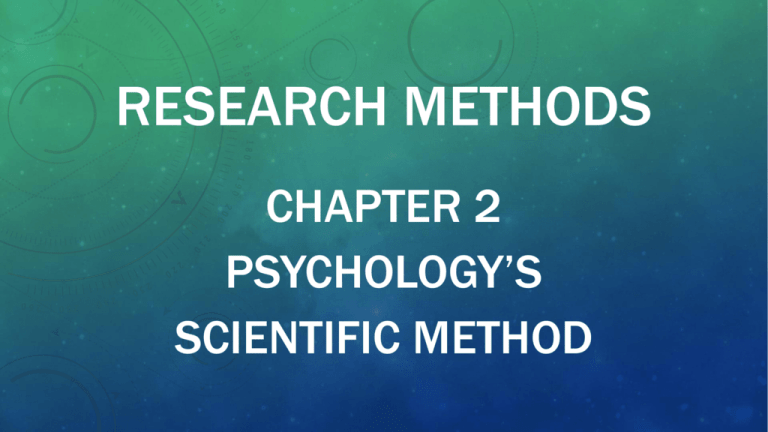
RESEARCH METHODS CHAPTER 2 PSYCHOLOGY’S SCIENTIFIC METHOD 4 GOALS OF PSYCHOLOGY 1) 2) 3) 4) Describe behavior Predict behavior Explain behavior Control behavior 5 STEPS OF THE SCIENTIFIC METHOD 1. Observing some Phenomenon 2. Formulating Hypotheses and Predictions 3. Testing through Empirical Research 4. Drawing Conclusions 5. Evaluating the Theory 5 STEPS OF THE SCIENTIFIC METHOD 1. Observing some Phenomenon • Asking questions • Variables 2. Formulating Hypotheses and Predictions 5 STEPS OF THE SCIENTIFIC METHOD 3. Testing through Empirical Research: Choose your research method Descriptive Research: describes some phenomenon • Naturalistic Observation • Survey/ Interview • Psychological/ Physiological Tests • Case Study • Archival Research Correlational Research: shows relationships Experimental Research: shows cause and effect 5 STEPS OF THE SCIENTIFIC METHOD 3. Testing through Empirical Research: Choose your research design (NOT for Experimental Research) Cross-sectional: Study participants of different age groups at the same time. • Advantage: quicker, less costly • Disadvantage: cohort effects, sample variability Longitudinal: Study a particular group of participants over a prolonged period of time. • Advantage: more in-depth investigation, shows change over time • Disadvantage: more costly, dropout/death 5 STEPS OF THE SCIENTIFIC METHOD 4. Drawing Conclusions • Replication • Descriptive/Inferential Statistics 5. Evaluating the Theory • Meta-analysis • Submitting results for publication INTRODUCTORY TERMINOLOGY FOR SCIENTIFIC RESEARCH •Variable: Any measurable condition that is controlled/observed in a study; anything that can change. •Theory: A broad idea or set of closely related ideas that attempt to explain observations and to make predictions about future observations. •Hypothesis: An educated guess that derives logically from a theory; a prediction that can be tested. •Operational Definition: An objective description of how a variable is going to be measured and observed. •Participants or subjects: The organisms whose behavior is systematically observed in a study. RESEARCH METHODS 1. Descriptive Research: • Naturalistic Observation • Survey/Interview • Case Study • Archival Studies NATURALISTIC OBSERVATION Description: Observing the participant in their natural habitat without interaction Advantages Disadvantages • Realistic picture of behavior • Difficult to remain unnoticed • Good to start when little is or unobtrusive known about a phenomenon • Time consuming SURVEY/INTERVIEW Description: Use of questionnaires to gain insight on an individual’s attitudes or beliefs Advantages • Gathers data of difficult to observe behaviors • Large sample size • Cost effective • Relatively easy Disadvantages • • • • • Wishful Thinking Memory Lapses Social Desirability Bias Response Set Wording Effect CASE STUDY Description: An in-depth investigation on an individual or cohort (small group) Advantages • In-depth investigation • Helps formulate theories • Unique cases Disadvantages • Subjectivity • Researcher bias • Lack of generalizability ARCHIVAL RESEARCH Description: Extracting evidence from original records or other researcher’s findings Advantages Disadvantages • Researcher can not change • Researchers have little to no data control over information • Cost effective • Credibility of sources RESEARCH METHODS 2. Correlational Research CORRELATIONAL RESEARCH • Research that examines the relationships between variables, whose purpose is to examine whether and how two variables change together. • There is NO manipulation of variables • CANNOT imply a cause and effect relationship between the variables CORRELATIONAL RESEARCH CORRELATION DOES NOT EQUAL CAUSATION! CORRELATIONAL RESEARCH • Scientists have linked • A local police chief in a television-watching with small Midwestern town childhood obesity. According finds that as ice cream to a study in the Journal of consumption increases, the the American Academy of crime rates increases. As Pediatrics, the degree of people eat less ice cream, obesity rises 2 percent for the crime rate decreases. each hour of television • The police chief concludes viewed per week by those that ice cream causes aged 12 to 17. crime. • Scientists conclude that TV watching makes you obese. CORRELATIONAL RESEARCH • Third variable problem: The circumstance where a variable that has not been measured accounts for the relationship between two other variables. CORRELATIONAL RESEARCH • Research study designed to determine the degree to which two variables are related to one another • When two variables are related to each other, they are co - related • A correlation is the numerical index of degree of relationship • Correlation are expressed as a number between 0 and 1 • Can be negative or positive (-1 to +1) • Numbers closer to 1 (+ or -) indicate a stronger relationship CORRELATIONAL RESEARCH CORRELATIONAL RESEARCH How to read a Correlation Coefficient: Correlation Coefficient: A statistical measure of the relationship between two variables. CORRELATIONAL RESEARCH Strength CORRELATIONAL RESEARCH Direction CORRELATIONAL RESEARCH POSITIVE CORRELATIONS 3.5 3 2.5 Height • As the value of one variable increases (or decreases) so does the value of the other variable. • The closer the correlation coefficient is to +1.0, the stronger the relationship. • A perfect positive correlation is +1.0 • Direct relationship 2 1.5 1 0.5 0 0 2 Weight 4 CORRELATIONAL RESEARCH • As the value of one variable increases, the value of the other variable decreases. • The closer the correlation coefficient is to -1.0, the stronger the relationship. • A perfect negative correlation is 1.0 • Inverse relationship Temperature NEGATIVE CORRELATIONS 4.5 4 3.5 3 2.5 2 1.5 1 0.5 0 0 2 4 Sweater Sales 6 CORRELATIONAL RESEARCH • There is no relationship whatsoever between the two variables. • The closer the correlation coefficient is to 0, the weaker the relationship. • No relationship Hours Spent Brushing Teeth ZERO CORRELATION 2 1.5 1 0.5 0 0 2 4 6 Kitten Perpetrated Homicides 8 10 CORRELATIONAL RESEARCH Coefficient of Determination: Percentage of variation in one variable that can be predicted based on the other variable. • Square the correlation coefficient by itself • Ex: .70² = .70 * .70 = .49 = 49% .24² = .24 * .24 = .057 = 5.7% CORRELATIONAL RESEARCH Description: determines the degree to which two variables are related to one another Advantages • No manipulation of variables • Allows large populations to be studied at one time • Cost effective and Quick • Enables investigation of difficult variables to study Disadvantages • CANNOT show cause and effect • Does not show the reason for the relationship

